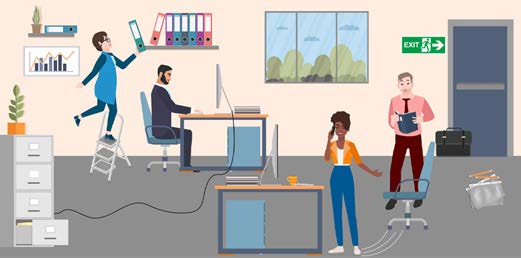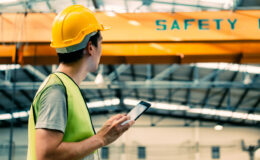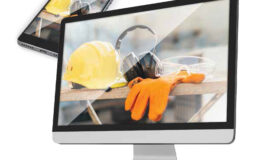By Travis Halsted, ARM, COSS
Loss Control Consultant
I hope that we are all getting excited about the holidays coming up, and that we are able to take a few moments to be thankful for positive aspects of our daily lives. I know that I am truly thankful for all of the efforts that our wonderful policyholders have done during these tough times to make safer workplaces.
I have been witness to incredible improvements within the many facilities that I visit. There have been astounding additions to machine guarding, the completion of safety programs, and the completion of employee training that has been absent in prior years. I want to commend all of you that have been taking these steps, as this was truly turbulent times and you continued to keep the safety of your employees at heart. While all of these additions are fantastic, we must always look for continuous improvements and one of the most overlooked places for safety is the office. These offices are often looked at as having minimal to no hazards and aren’t part of the normal hazard assessment. Even the best safety professional may rush to the production floor, and not even realize the plethora of exposures that can be found in the offices. This article will provide you with some items that you may be aware of, as well as some that you are not, but I hope that either way it provides you with some items to add to a checklist or risk assessment.
Bookshelves & Racking – In many offices there is a room that is referred to as the file room, or archive room. This room is often packed full of boxes. These boxes are often placed on storage racks that are usually 4 – 5 shelves high and in rows. While this is much safer than stacking boxes on top of each other, we must also think about those shelving units. They, just like shelving units on the production floor, can tip over. Those tipping units can tip other units, subsequently causing a domino effect. Securing the shelving units to each other or securing them to the floor/wall would prevent this type of scenario. Another aspect of this would be to ensure that the aisles in between the shelving units remains clear.
File Cabinets – File cabinets, much like bookshelves & racking, can often provide a tip hazard. Employees will open the top drawers and not realize that the cabinet is then top heavy and subject to very easily tipping towards the employee. The employee could be crushed by the tipping file cabinet. Due to this, file cabinets should be secured to a proper securing point in the wall. By simply securing the file cabinets, the likelihood of a tipping file cabinet is greatly reduced, if not eliminated.
Ladders/Step Stools – In an office setting, employees often take matters into their own hands. This would include changing lightbulbs, hanging pictures, or even installing an additional light fixture. While the production floor may have ladders in several locations, an office won’t necessarily have them. This leads employees to use items like their chairs, or even standing on their desk to raise them to an elevated level. This can lead to falls from said items, and should be prohibited. Instead, an office should have its own designated ladder or step stool, and employees should be trained on when and how to use them, and only for tasks that they are permitted to do. Ideally, if a maintenance person is available to complete the desired activity then that person would be utilized, but if not then the step stool/ ladder mixed with training is a must.
Electrical – As office areas are often in need of numerous plugs for lamps, computers, chargers, fans, and an extensive list of other items, there will often be power bars, and extension cords. These items, by themselves, are usually safe to use. When the power bars are overloaded, and extension cords are placed under rugs and mats, that is where the hazards present themselves. By walking on the cords they can be easily damaged and cause a fire hazard. Coffee pots, space heaters, toasters and other heat producing items should be unplugged when not in use. Finally, any damaged cord should be reported to your supervision immediately.
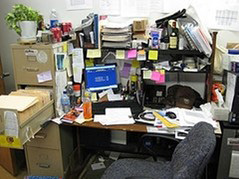
Desks – An employee’s desk can provide all sorts of different types of hazards. One of the simplest errors, like leaving a drawer open can cause a person to trip and fall. This simple type of trip and fall has been responsible for fractured wrists, contusions, concussions and strains. The cluttering of the desk with piles and piles of different items serves as a fire hazard in the event of an ignition of some sort. Clutter should be removed from the desk as soon as possible.
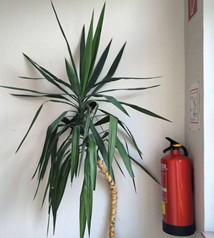
Exits & Fire Extinguishers – Blocked EXITs and fire extinguishers are pretty common in an office setting. Whether it be a new plant, boxes of paper that were just delivered from the local office supplies store, or even file cabinets that needed some where to be, EXITs and fire extinguishers just seem to disappear in the office. Another part of proper EXIT door egress is security. Many offices are improving their security and, as part of limiting access, have put access controlled doors in places that are in an EXIT door egress path. If an employee doesn’t have access to that area then they won’t be able to EXIT. As security is a vital part of any operation, your layout of EXITs should include an assessment of this particular item and make sure that those EXITs are not part of the EXIT route for the employees.
Ergonomics – Ergonomics is rapidly growing into one of the most developed parts of safety and health management systems. The study of body movements, positions, distance to items, and just an overall understanding of why the body becomes uncomfortable and injured is vital to lowering strain type claims. The office setting has items like keyboard and monitor measurements, posture recommendations for sitting in a chair, desk height and floor mat recommendations, and even standing versus sitting recommendations. All of these items can be measured and analyzed through an ergonomics survey by a trained professional.
As you can see from some of the items pointed out, any one of our loss control visits can be focused on just the office setting alone. I challenge each of us to look at our offices. Look at how we can improve the safety of our office, and the office as a whole. I am willing to bet that you will find someone standing on their swivel chair, or a nice new office plant blocking a fire extinguisher. If you are ever interested in having an ergonomics survey done on any of your office areas, please reach out to your Loss Control Consultant, and we are happy to inform you of that process. I hope that you all have an amazing and SAFE holiday season!

